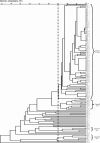Spread of Escherichia coli strains with high-level cefotaxime and ceftazidime resistance between the community, long-term care facilities, and hospital institutions
- PMID: 16825350
- PMCID: PMC1489527
- DOI: 10.1128/JCM.00447-06
Spread of Escherichia coli strains with high-level cefotaxime and ceftazidime resistance between the community, long-term care facilities, and hospital institutions
Abstract
A total of 151 Escherichia coli strains resistant to cefotaxime and ceftazidime were isolated during a prospective surveillance study. These strains were characterized by clinical, microbiological, and molecular analyses and were distributed into four clusters of 103, 11, 6, and 5 isolates, along with 25 unrelated strains. The principal cluster was isolated from urine, wound, blood, and other samples in three hospitals, eight nursing homes, and a community healthcare center. This cluster was associated with both nosocomial (65%) and community-acquired (35%) infections. Most strains were resistant to ciprofloxacin, gentamicin, tobramycin, cefepime, amoxicillin-clavulanic acid, and trimethoprim-sulfamethoxazole but were susceptible to imipenem. All isolates from the four clusters expressed the extended-spectrum beta-lactamase (ESBL) CTX-M-15. This enzyme was also present in 8 (30.8%) of the 26 unrelated isolates. The other ESBLs, CTX-M-14 and CTX-M-32, were detected in five and seven cases, respectively, but they were detected in individual E. coli isolates only. In three clusters, blaCTX-M-15 alleles were linked to an ISEcp1-like element, while in eight strains of cluster II an IS26 element preceded the blaCTX-M-15 allele. An additional pool of resistance genes included tetA, drfA14 or dfrA17, sul1 or sul2, aac(6')Ib, and aac(3)IIb. All except one of the 27 isolates tested for genetic virulence markers harbored the same three virulence genes: iutA and fyuA (siderophores), and traT (serum survival factor). Epidemic or occasional isolates of cefotaxime- and ceftazidime-resistant E. coli can spread between distinct health facilities including hospitals, community health centers, and long-term care centers.
Figures



References
-
- Boyd, D. A., S. Tyler, S. Christianson, A. McGeer, M. P. Muller, B. M. Willey, E. Bryce, M. Gardam, P. Nordmann, and M. R. Mulvey. 2004. Complete nucleotide sequence of a 92-kilobase plasmid harboring the CTX-M-15 extended-spectrum β-lactamase involved in an outbreak in long-term-care facilities in Toronto, Canada. Antimicrob. Agents Chemother. 48:3758-3764. - PMC - PubMed
-
- Clinical and Laboratory Standards Institute. 2005. Performance standards for antimicrobial susceptibility testing-15th informational supplement. Approved standard M100-S14. CLSI, Wayne, Pa.
Publication types
MeSH terms
Substances
LinkOut - more resources
Full Text Sources
Medical

